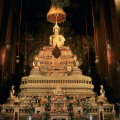WAT PHO - TEMPLE OF THE RECLINING BUDDHA
Go there and contact

A temple located in Bangkok, famous for its Reclining Buddha awaiting death, a statue erected by Rama III in 1832.
Wat Pho, whose full name is Wat Phra Chettupon Mangkhalaram Ratchaworamahawihan, is one of the oldest temples in the country. It is sometimes called the Temple of the Reclining Buddha or the Temple of Illumination. It is in Chettuphon Road that General Chakri proclaimed himself king under the name of Rama I and that in 1781 he made enlarge the old sanctuary which was already there. This temple, the oldest of Bangkok, is cut in two by Chettuphon where the entrance is. On one side stands the temple proper and on the other the monastic quarter. Wat Pho is best known for its reclining Buddha awaiting death; it is the largest image of Buddha in this attitude. The statue, erected by Rama III in 1832, is 43 meters long and 15 meters high. The soles of the feet, inlaid with mother-of-pearl, bear the 108 auspicious marks that Buddha wore at his birth.
Next to the viharn, the library, decorated with Chinese mosaics, preserves the sacred manuscripts. It is one of the largest buildings in the complex. Four large chedi representing the first four kingdoms can still be seen. The chedi covered with green mosaics is 41 m high and contains a Buddha image from Ayutthaya, which was damaged by the Burmese. This chedi was built by Rama I. King Rama III had the white chedi built in honor of his father Rama II and the yellow chedi in his own honor. The blue one was built by Rama IV to commemorate Queen Sri Suriyothai of Ayutthaya.
The traditional medicine pavilion, at the foot of these chedi, displays drawings of the human body with acupuncture points as well as herbal recipes.
There are also stone statues (brought back from China in the 19th century) with beards and hats, which remind visitors of European faces. These are the "demons" who guard the temple. Remember that the Chinese call the Europeans "red demons".
The main bot houses a representation of Buddha in bronze in meditation. On the walls are painted the biographies of 47 eminent disciples of Buddha. More interesting are the bas-reliefs on the balustrade that surround the statue and depict scenes from the Ramakien.
The four viharns at the four cardinal points surrounding the main bot have interesting images of Buddha, showing him sitting on a rock, or protected by the Naga king.
Did you know? This review was written by our professional authors.
Members' reviews on WAT PHO - TEMPLE OF THE RECLINING BUDDHA
The ratings and reviews below reflect the subjective opinions of members and not the opinion of The Little Witty.














Sa visite se combine facilement avec celle du Palais Royal.(situé non loin du Wat Po)
Le Wat Pho (souvent écrit et prononcé Wat Po) de son nom complet Wat Phra Chetuphon (temple du Bouddha couché) est l’un des plus anciens monastères de la ville de Bangkok.
Le Wat Po abrite de nombreuses pièces de collections de l’art thaïlandais (peintures, sculptures, statue de Bouddha,…) dont le plus célèbre est l’image du Bouddha Couché de 45 mètres de long et 15 mètres de haut. Cette statue de Bouddha représente Bouddha sur le point d’accéder au Nirvana.
Avant tout chose, sachez que le Wat Po est avant tout un lieu de culte bouddhique où des rites religieux sont exécutés par les moines du temples. Faites donc en sorte de ne pas faire trop de bruits et habillez-vous de manière convenable (le port de shorts et de mini-jupes sont interdits dans l’enceinte du Wat Po). Avant de rentrer à l’intérieur de chaque bâtiment, veuillez à enlever vos chaussures.
L’entrée principale du Wat Po se situe sur la rue Chetupon (Tanon Chetupon) qui est parallèle à la rue Sanam Chai située non loin de l’embarcadère de Tha Tien (station n°8 du bateau public).
Au moment d’acheter votre ticket d’entrée, vous pouvez si vous le désirez opter pour une visite guidée par un guide du temple. Il vous en coûtera environ 200 bahts.
Les touristes se ruent habituellement vers le bâtiment principal (Bat n°2 sur la carte) (là où est entreposé le Bouddha couché de 45 mètres). Si vous voyez qu’il y a beaucoup dans le bâtiment principal, commencez par la visite des jardins de Wat Po situé à l’ouest du site ou par les pavillons de massage situé à l’est (bâtiment n°14) puis finissez par visiter le Bouddha Couché.
A l’arrière du Bouddha couché, vous verrez certainement une longue lignée de bols en métal. Les croyants laissent une pièce de 1 bath dans chaque bol pour attirer chance et prospérité. Ces bols appelés également bols du mérite. Si vous désirez attirer chance et bonheur, laissez à votre tour une pièce de 1 bath dans les bols du mérite : des petits bols de pièces sont disponibles contre 25 bahts.
Le Wat Po est un temple agréable notamment à la tombée de la nuit à l’approche de l’horaire de fermeture. Généralement peu fréquenté vers 16 h 30, il y règne une atmosphère apaisante, vers 17 h, les moines du temple viennent prier dans l’enceinte du bâtiment principale.
https://www.tripadvisor.fr/ShowUserReviews-g293916-d311043-r258018582-Temple_of_the_Reclining_Buddha_Wat_Pho-Bangkok.html#